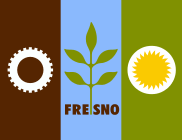Forestiere Underground Gardens
|
Forestiere Underground Gardens | |
|
View from the street | |
   | |
| Location | 5021 W. Shaw Ave., Fresno, California |
|---|---|
| Coordinates | 36°48′26″N 119°52′51″W / 36.80722°N 119.88083°WCoordinates: 36°48′26″N 119°52′51″W / 36.80722°N 119.88083°W |
| Architect | Forestiere,Baldasare |
| NRHP Reference # | [2] |
| CHISL # | 916[3] |
| Added to NRHP | October 28, 1977 |
Forestiere Underground Gardens Located at 5021 West Shaw Avenue in Fresno, California are an unusual manmade creation built by Baldasare Forestiere, an immigrant from Sicily, over a period of 40 years from 1906 to until his death in 1946. It is operated by members of the Forestiere family through the Forestiere Historical Center, and can be considered a spectacular and unconventional example of vernacular architecture.
The catalyst for the construction of the underground abode was a result of the hot summers typical of the Fresno area. The inspiration lends itself to ancient Roman catacombs that Baldasare was infatuated with in his youth. Countless hours were spent excavating the hardpan layer that cements much of Fresno’s soil to create his underground home. It had a summer bedroom, a winter bedroom, a bath, a functional kitchen, a fish pond, and a parlor with a fireplace.[4] Interspersed amongst the beautiful stone walls and archways are grottoes and courtyards that allow for pockets of light. The intricate pathways were created section by section, over a span of 10 acres, without the aid of blueprints.[5]
Dimensions
There are three levels within this underground structure:
- Level One: 10 feet deep
- Level Two: 22 feet deep
- Level Three: 23 feet deep
Architecture
The gardens, while subterranean, have many skylights and catchbasins for water. The dirt that was moved to create the large structure was utilized elsewhere to fill planters, create stones placed within the catacombs, and to level out other parts of the land. The pathways and rooms were constructed with various widths to help direct airflow by creating pressure as it moves through narrower portions and maintain movement as it bounces off the slants and curves of the cavernous walls. The conical skylights allow for the hot air to be pushed out more quickly and the cool air to remain below.
Horticulture
The plants and trees, some of which are over 100 years old, are protected, by virtue of construction, from the frost in the winter months. Each level was planted at different times, so they bloom in succession, in order to lengthen the growing season. It houses a variety of fruit ranging from citrus and berries to exotic fruits like the kumquat, loquat, and jujube. The trees have been grafted to bear more than one kind of fruit, allowing for a larger variety to be grown throughout the space. Trees and vines were also planted above the dwelling, acting as insulation and formed canopies that provided protection from the elements.
Designations
It is listed on the National Register of Historic Places. It is registered as No. 916 on the list of California Historical Landmarks.
See also
- Hermit House, a residence located in Herzliya, Israel with mosaics constructed by one man over thirty years.
- Watts Towers in Los Angeles, a collection of 17 interconnected structures, built by Italian immigrant Sabato Rodia.
- Nitt Witt Ridge a house in Cambria, California constructed in a similar style.
- Ferdinand Cheval, a French postman who constructed an "ideal palace" out of rocks in his spare time.
- House on the Rock Alex Jordan,Jr. constructed "Japanese House" atop rock pinnacle in Spring Green, Wisconsin.
References
- ↑ "Forestiere Underground Gardens". Office of Historic Preservation, California State Parks. Retrieved 2012-09-05.
- ↑ National Park Service (2008-04-15). "National Register Information System". National Register of Historic Places. National Park Service.
- ↑ "Forestiere Underground Gardens". Office of Historic Preservation, California State Parks. Retrieved 2012-09-05.
- ↑ Forestiere Historical Center, Retrieved 27 Apr. 2013.
- ↑ Forestiere Underground Gardens, Retrieved 27 Apr. 2013.
External links
- Forestiere Underground Gardens
- Baldasare's Magnum Opus
- Thomas Curwen (January 29, 2004). "Dreams dwelled here". Los Angeles Times.
- Baldasare Forestiere's Underground Gardens
- "Under California- California's Gold (509)". Huell Howser Archive. Chapman University. 1994. Retrieved 31 May 2013.


